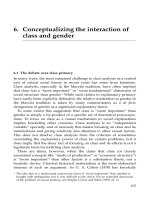That instead of which and who
Bạn đang xem bản rút gọn của tài liệu. Xem và tải ngay bản đầy đủ của tài liệu tại đây (8.35 KB, 1 trang )
That instead of which and who
The relative pronoun ‘that’ is sometimes used instead of ‘which’ and ‘who’.
Study the examples given below.
The man who called yesterday was rather rude.
OR
The man that called yesterday was rather rude.
The coffee machine which I bought for my wife was expensive.
OR
The coffee machine that I bought for my wife was expensive.
‘That’ is less formal than ‘which’ or ‘who’ and can refer to both people and things. Which, on the other hand, can
only refer to things and ‘who’ can only refer to people.
Note that ‘that’ can only be used in identifying or restrictive relative clauses.
An identifying relative clause gives information that is necessary to identify the person or thing we are talking
about.
For example, in the sentence ‘The coffee machine which I bought for my wife was expensive’, the relative clause
‘which I bought for my wife’ explains which coffee machine we are talking about.
In such clauses ‘that’ can be used instead of ‘which’.
In non-identifying relative clauses ‘that’ cannot be used.
Study the example given below.
Rabindranath Tagore who won the Nobel Prize for Literature was also an accomplished painter.
Here the relative clause ‘who won the Nobel Prize for Literature’ is not required to identify Rabindranath Tagore.
He has already been identified by his name.
In such clauses ‘that’ cannot be used.
For example, you can’t say: Rabindranath Tagore that won the Nobel Prize for Literature was also an
accomplished painter.
Non-identifying relative clauses are set off using commas. Commas are not used to separate identifying
relative clauses.
Stay on top of your writing! Download our grammar guide from www.englishgrammar.org to stay up-to-date.
Powered by TCPDF (www.tcpdf.org)









